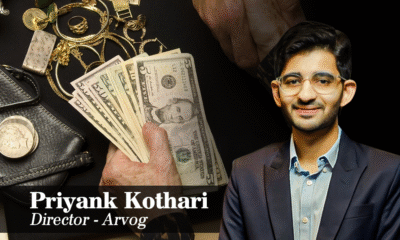By Invitation
Golden Rule III – New Product Introduction


L.R.Natarajan, Partner- Strategy and Systems Consulting
LRN has worked at senior level positions in companies like Eicher Motors, Hero Motors, Greaves Cotton, Ashok Leyland, and Hindustan motors. His last employer was Titan Company limited. Eleven years in Titan Company limited (eight years in Tanishq) and retired as CEO for the new business division. LRN was also heading the innovation council at Titan and was an active member of Tata Group Innovation Forum.
LRN had successfully spearheaded the TOC implementation in Tanishq retailing.LRN had started a school for Innovation in Titan and the school had produced over 400 trained innovators.
LRN also undertakes consulting assignments from corporate companies on Strategy, Retail excellence and Innovation. He has recently authored two books, a book on Innovation titled “The 9 Nuggets of Innovation” and a book on retailing titled “Demystifying Retail” – The Four golden rules.

Prabhakar Mahadevan, Founder Director of Strategy and Systems Consulting & Focus and Flow
Technologies Pvt Ltd
Prabhakar is a certified Theory of Constraints consultant (TOC) by Goldratt Schools Israel, certified expert on TOC by TOCICO (www.tocico.org) & is associated with TOC for the last 22+ years.
Through his consulting companies,Prabhakar and his colleagues are involved in several comprehensive TOC consulting projects across several industry verticals such as fashion jewellery, fast moving consumer goods, consumer durables, automotive OEM, capital machinery, pharmaceutical, heavy engineering, fashion retail etc.
In continuation of my article titled “The Four Golden Rules for securing retail excellence”, I am detailing through this article, the third Golden Rule: “Processes for New Product Introduction”.
1. Background
NPI, New Product introduction, is an essential part of any retailing. However, if the NPI is not guided by right processes, NPI process will turn out to be the key driver for accumulation of obsolescence. A wrong NPI process may give room for replacing the fast movers in accommodating new designs which do not have any sale history. Therefore, having the right NPI process will guide one through in which category, in which price point, how much of merchandise is to be introduced. With the right NPI processes in place, the obsolescence can be considerably minimised, and the fast movers can be increased.
2. New Product Introduction Process
There are four parts to the NPI process as defined below. Having the right processes for each aspect of NPI process, should lead to defining the comprehensive NPI process
1) What should be the frequency of NPI?
2) How much of Newness in each NPI?
3) The understanding of distribution of newness, across category and price points.
4) Zeroing down on the right set of designs, to maximise the chances of success.
2.1 What Should be the Frequency of NPI?
It is very important to arrive at the logical answer to this question. While newness is a prerequisite for any retail, it is to be understood that the new products come with Zero sale history. Also, one needs to vacate some of the merchandise from the current inventory mix to accommodate new products. The risk of obsolescence will be high with higher NPI. Conversely the excitement of NPI introduction and its impact on sale will be less with lesser NPI.
How does one arrive at the frequency of NPI?
It is to be understood that the NPI is be done to create excitement followed by desire in one’s customer base to walk in and buy and NPI is not being done to fulfil the Merchandising/ retail teams need. Having very clearly understood this, one should try and understand the customer buying behaviour. A customer buying Jewellery perhaps will frequent the Jewellery showroom (most of the customers) once or twice in a year.
From the customer walk-in data available, one should compute what % of customers are buying once/twice/thrice in a year and arrive at the average per customer repeat walk-ins in a year. Assume this number arrived at is 2 for a given retailer, meaning on an average, the customer walks in twice in a year. Therefore, when the customer walks in for the second time, there should be newness in the showroom.
With this one can conclude that the new products for this retailer, is to be done once in 6 months, and during the seasonal months
2.2 How much of Newness in each NPI?
Having decided that the NPI will happen every 6 months, the next logical question that needs to be addressed is how much of new products to be introduced in each NPI meet.
50% newness once in 6 months, results in the entire merchandise will be new in a year. And with 10% newness every 6 months, in a year 20% of merchandise will be new. Too much of newness, will lead to greater risk of obsolescence and too less newness, will not create the excitement in customer base.
The suggestion here is that key members from Product design / Marketing / Category / Merchandise and retail should understand the ramification of introducing newness and arrive at a consensus on the quantum of newness to be introduced in the NPI event. Based on the impact of introducing the newness based on consensus arrived at, the next year newness % can be fine-tuned.
Our recommendation will be to plan for a newness of 30% every year, 15% during Diwali/ Dhanteras and 15% during Akshaya Tritiya.
2.3 Understanding of distribution of newness across category/Price points
Referring to my earlier article on the second golden rule, Planogram and Replenishment process, I had explained about the 2*2 process. We had compiled the sale and stock turn of each showroom category/ sub-category/ price point wise, and compared the same with the group average sale and group stock turn and arrived at to which of the four quadrants the individual line item in a showroom belongs to, Q1, Q2, Q3 or Q4. I am compiling the 2*2 matrix for one’s ready reference, with certain additional notes.

As can be inferred from the above, for a given showroom, for the category / Sub- category/ price points falling under Q3 and Q4 are the areas where maximum of new products is to be introduced. Here again the quantum of new products will be governed by the newness % arrived at earlier.
To reap the full benefits of NPI, it is recommended that NPI should have more variants (70 to 80%) falling under Q3 and Q4, and less variants to be introduced for the line items falling under
2.4 Zeroing down on the right set of designs, to maximise the chances of success
Having arrived at showroom wise Category/ Sub- category/ Price point wise, number of new products to be introduced, (say 10 for a given line item)
- For a category/ Sub- category/ Price point if 10 new designs are to be introduced
- Secure 30 new designs (Three times the final requirement)
- Let the category/design/retail team choose 20 best ones from the above, by appropriate voting process
- Show case these 20 to your loyal customer base and have processes in place for short listing the best 10
Processes described above for NPI will for sure increase the chances of success at the marketplace. However, the caution here is that one needs to prepare a calendar of activities, covering all the processes described above, to ensure that one adheres to the deadline defined for NPI.
Summing up
While introducing new products is essential for any retail business, one should think through and arrive at the appropriate processes, for the four steps given below
- What should be the frequency of NPI?
- How much of Newness in each NPI?
- The understanding of distribution of newness across category and price points.
- Zeroing down on the right set of designs to maximise the chances of success
New product introduction, done without proper processes, will be the starting point of sludge stock generation in the inventory.

By Invitation
Arayian Jewellery: Weaving Heritage, Craftsmanship, and Modern Elegance into Every Gemstone
By Shivaram A
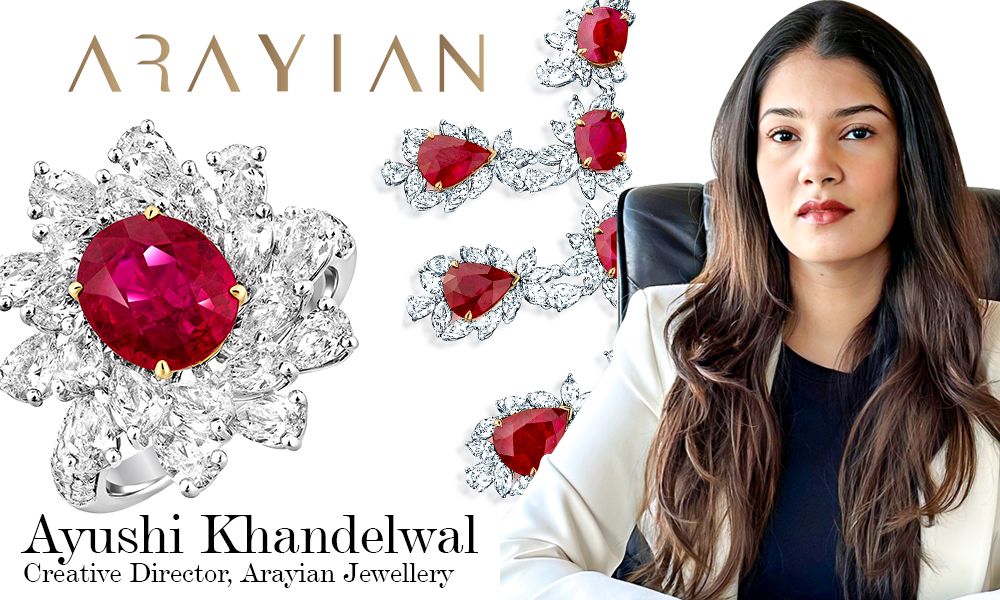
Arayian Jewellery, a distinguished name in the world of fine coloured gemstone jewellery, is redefining elegance through a rare blend of legacy, craftsmanship, and modern design.

Spearheaded by Ayushi Khandelwal, the brand draws from generations of expertise in gemstone trading and jewellery making. With a commitment to authenticity, vertical integration, and a deep respect for cultural roots, Arayian offers more than just jewellery—it offers heirlooms crafted with heart, history, and a forward-looking vision.
Here’s what Ayushi Khandelwal, Creative Director of Arayian Jewellery, has to say about the brand’s journey, philosophy, and vision for the future.

1. How do you define the legacy of Arayian Jewellery?
Arayian Jewellery is built on a legacy of generations deeply rooted in the world of fine jewellery and gemstone trading. Surrounded by exquisite stones and craftsmanship from a young age, we channel this heritage, passion, and knowledge into creating timeless pieces for our clients—offering not just jewellery, but a legacy of love and refinement.
2. Explain the USP of your brand.
We are involved in the entire journey—from sourcing rough gemstones and cutting them in-house to crafting fine jewellery. This unique vertical integration allows us to offer bespoke, high-end pieces with unmatched precision and quality, all under one roof.
3. What is your design philosophy?
Our designs revolve around the natural beauty of precious gemstones. We aim to create modern, elegant, and everlasting pieces that highlight the uniqueness of each stone while maintaining a timeless aesthetic.
4. Kindly provide details of your product offerings—bridal & jewellery collections or others.
We specialize in exclusive fine jewellery crafted with natural, coloured gemstones. Every piece is one-of-a-kind, celebrating individuality with authenticity and certified provenance. Our offerings include bridal collections, statement jewellery, and heirloom-worthy pieces.
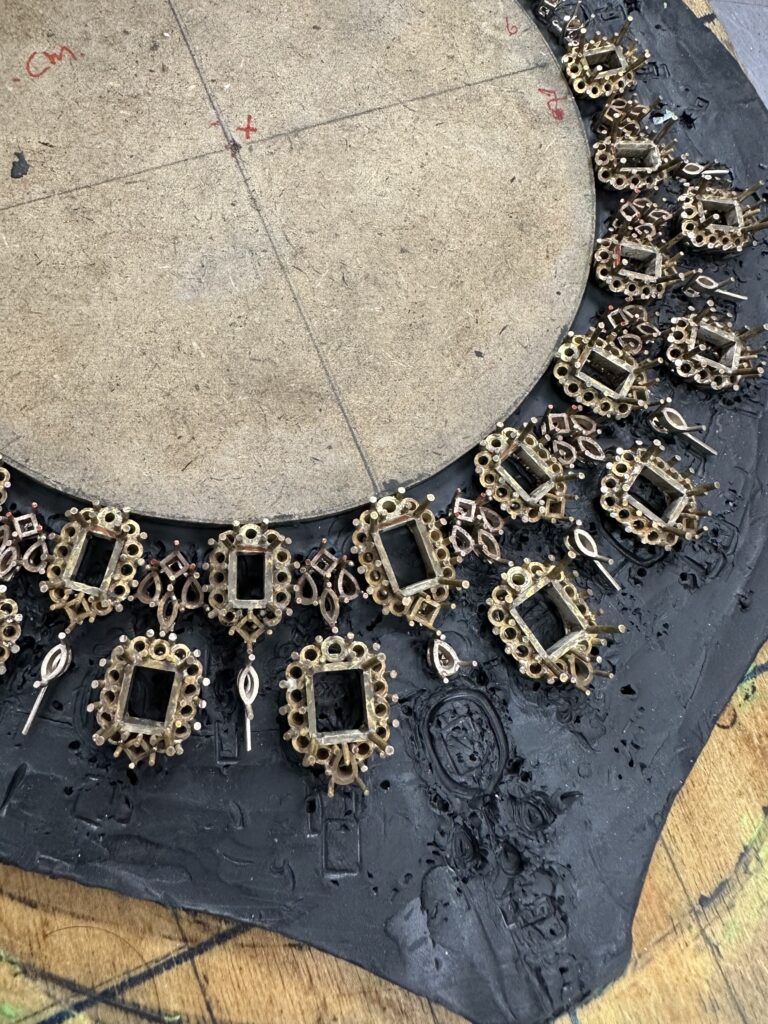
5. How do you ensure that your jewellery designs reflect cultural heritage while appealing to the evolving tastes of younger generations?
By embracing clean, contemporary aesthetics while honouring the intrinsic elegance of traditional gemstones, we create designs that resonate with modern sensibilities without losing their cultural soul. The coloured stones remain the centrepiece of our creations, offering a bridge between heritage and innovation.
6. What role does sustainability play in your sourcing and crafting processes?
We source our gemstones responsibly, primarily via auctions from the likes of Gemfields. Our in-house cutting of rough stones not only reduces environmental impact but also ensures every layout is distinctive and responsibly crafted.
7. How does your brand differentiate itself from traditional jewellery makers in Jaipur in terms of craftsmanship and innovation?
Our commitment to international standards of craftsmanship sets us apart. Each piece is designed for enduring comfort, precision, and wearability, combining traditional artistry with cutting-edge techniques for global appeal.
8. What specific measures have you taken to make your jewellery accessible to a global audience without compromising cultural authenticity?
We actively participate in prestigious international exhibitions, making our work accessible to clients across the globe while staying true to our roots in artisanal gemstone craftsmanship.
9. How do you incorporate modern technology, such as AI, in jewellery designing?
Our design process is grounded in hand-sketching and personal inspiration drawn from travel and surroundings. While we honour traditional design methods, we remain
open to integrating modern tools, including AI, to enhance precision and creativity in future collections.
10. Where does Arayian Jewellery see itself in the coming years? What is the roadmap?
We envision Arayian Jewellery becoming a globally recognized name in fine coloured gemstone jewellery—synonymous with excellence, authenticity, and innovation. Our roadmap includes global expansion, increased visibility through exhibitions, and continuously elevating our craftsmanship.
11. Where is Arayian Jewellery’s presence beyond the Indian market?
Arayian Jewellery has an international footprint through exhibitions and showcases in key global markets including Bangkok, Qatar, Turkey, Hong Kong, Las Vegas, and Singapore, allowing us to connect with a discerning global clientele.
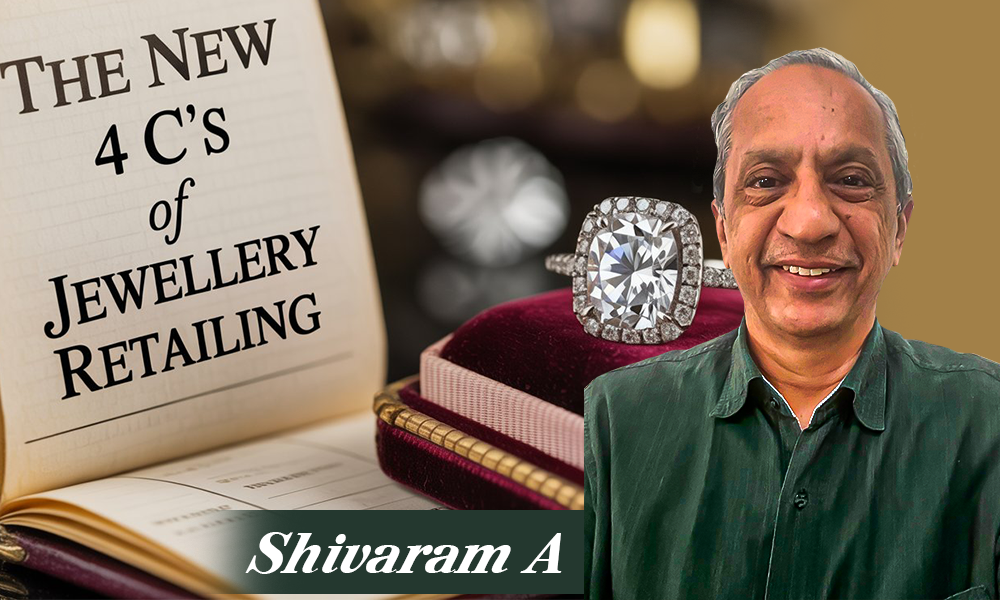
Jewellery is a precious commodity to purchase, and every customer wishes to take a cautious decision. Most of the purchase decisions of the jewellery customer is dependent on her “perception” of the brand or the jeweller. Keeping this in mind, certain parameters can be defined to help the customer make a quick and correct decision. For example, while buying diamond jewellery, 4 factors were considered as the “C”s- cut, carat, colour and clarity of the diamonds.
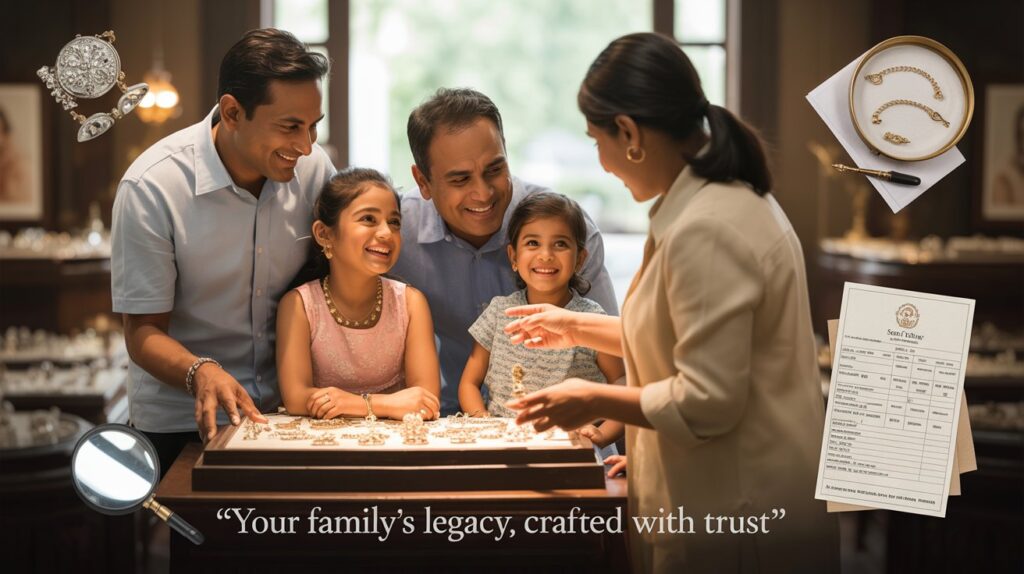
Likewise, the present customer’s buying behaviour rests on the 4 new “C”s of Jewellery Retail. What are these 4 new “C”s? Let us take a look.
The 4 new “C”s
Today’s customer’s mindset has undergone a huge transformation due to the accessibility to international trends and markets (maybe due to travel or just social media) and a wide range of designs and services are now available at jewellery stores. The buying behaviour of the current customers is governed by certain factors which are depicted below.
Observing the rankings (see Figure “Factors considered while selecting a Brand”), we can conclude that a jewellery customer’s purchase decision is based on the 4 new “C” s – Cost, Confidence, Convenience and Customer Service.
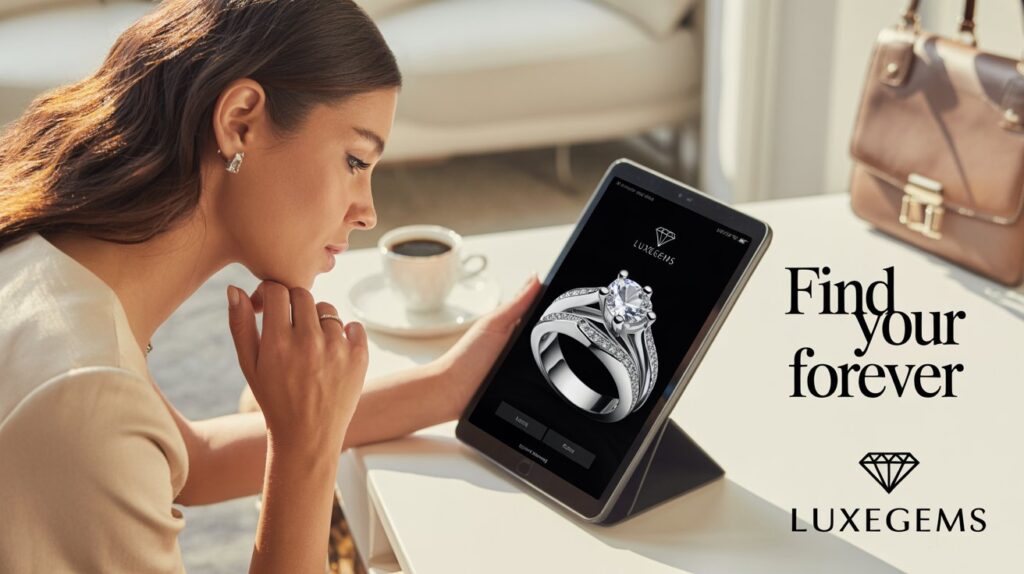
1. Cost- the first “C”
Let us face it. You, me and almost every Indian is very price conscious. Thus every customer wants to have the full value for her money- “Full paisa vasool / Good Deal” This is more so in the case of jewellery retail due to the high costs involved in the purchase. Cost is thus the dominating factor in the purchase decision of a jewellery customer. This cost of jewellery includes the making charges and the cost of the gold paid out as wastage. If this final cost looks affordable and justified to the customer, you, the retailer can make a sale.
So, the first “C” in the purchase decision is COST and as a jewellery retailer, you must position your brand rightly with respect to “cost”.
There are brands where the Making Charges / Value Addition is advertised in Bold while there are other brands like Malabar Gold or Tanishq, which may not be the cheapest in pricing but will want to still offer “Value for Money” for their set of customers. These customers might be very different from the customers for say a price warrior brand, but their customers also believe that the cost is worth it.
2. Confidence- the second “C”
A customer’s confidence in the jewellery brand starts with how the brand meets her expectations right from her first interaction during say marketing communication, her first purchase and goes on to maintain that confidence that is reflected in her repeat purchases and referrals. Word-of-mouth referrals and relatives’ recommendations still form some of the influencing factors of jewellery purchases.
Trustworthiness of a brand is a mark of the confidence the customer has in the jewellery retailer and this is an aggregate of several factors which include purity, pricing, discounts, shopping experience, after-sales service etc. A customer, who feels that the jeweller can give her
the best in all the above factors, has typically won her confidence.
This clearly shows that the “confidence” of the customer in the brand is emerging as the second “C” and it is the most important factor in brand perception and purchase decision.
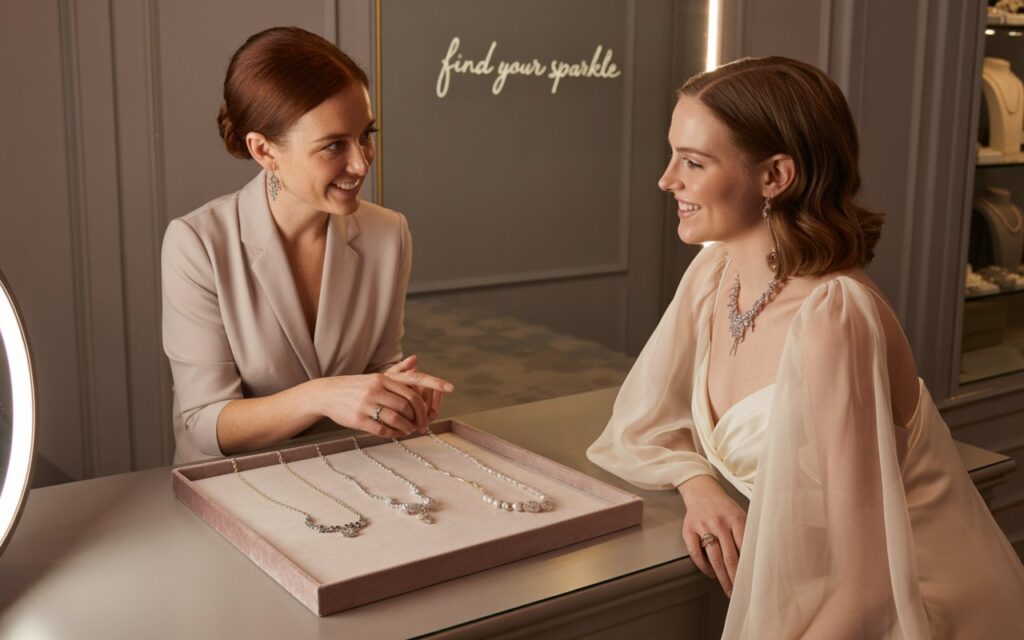
3. Convenience- the third “C”
Jewellery is still a “touch and feel” market where purchases are made in person. But of late, convenience in jewellery shopping is emerging as one of the decisive factors in jewellery purchase.
Today’s customers are well-informed about the price fluctuations, making charges, wastage, and design options etc. even prior to the actual physical purchase at the shop. The presence of a website or social media like Instagram/ Facebook etc. with a design gallery and price estimates are often appreciated by customers as it helps them in planning their purchase. Such a convenience-driven model of business with knowledge-empowerment is the call of today for jewellery retailers.
This is why Convenience is emerging as the third C in brand positioning or purchase decisions.
Customers look at “customization” as part of the convenience offered by a jeweller. The convenience of customization is an added benefit offered by jewellers. Convenience also means service benefits that the jewellery outlet offers like “home delivery” or”gifting options”.
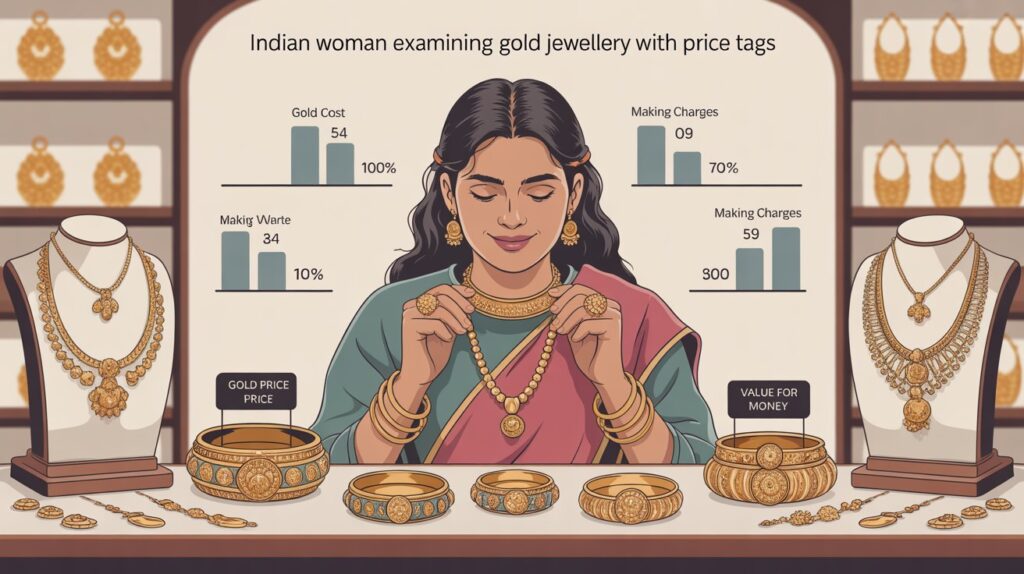
4. Customer service – the 4th C
A jewellery purchase is an emotional decision for most buyers as they attach great sentimental and personal value to the jewellery they purchase. This is why customers look for a “positive shopping experience” when they come to buy jewellery. This positive shopping experience is founded on the 4th C -customer service.
Customer service involves not only hospitality and friendly greetings but also expertise from the staff. Customers expect well informed staff to guide and advise them on their jewellery choices.
Ganesh Jewellers of Mumbai wish to position themselves with respect to their customer service. Look at what they say –
Right from the marketing communication, the entry to the store/ website, the warm welcome, the store atmosphere, the hospitality gestures, the offers on the merchandise including the range, the price, the design etc. to the customer-handling, everything in your jewellery outlet should enrich the 4th C – the customer service.
The Jewellery industry may see its ups and down regularly, but if you keep these 4 Cs in mind and position your brand or jewellery outlet, you are sure to be the champion of jewellery retail in your market and beyond.

The ease and convenience of gold loans is the prime reason for its huge popularity and accessibility. Being a secured loan, it does not require much documentation and processes. Gold loans in India have been emerging as the most popularly accessed credit form. With such huge popularity of gold loans, the scamsters also get active to cheat people. Read here to identify between the genuine gold lenders and fake ones.
Gold loans have emerged as one of the most accessible and dependable forms of credit in India. They are easy to apply for, processed quickly, and disbursed almost immediately. What makes them particularly attractive is the minimal paperwork involved and the fact that they usually bypass long credit history checks.
However, as the popularity of gold loans grows, so does the risk of falling victim to fraud. Many individuals in urgent need of funds become easy targets for scammers posing as gold loan providers. These fraudsters exploit the borrower’s urgency and trust, often leading to significant financial losses.
Red Flags: How to Spot a Fake Gold Loan Lender
Fraudulent lenders often try to lure borrowers with offers that seem too good to be true. Watch out for the following warning signs:
- Unrealistically Low Interest Rates: Be cautious if the rates offered are far below the market average.
- Inconsistent or Delayed Communication: Lack of professionalism or delayed responses could signal a scam.
- No Contact Information: A legitimate lender will always provide verifiable contact details.
- Unclear Loan Terms: If terms and conditions are vague or not explained properly, that’s a red flag.
- Missing Licenses: Genuine lenders are licensed and regulated by appropriate authorities.
- False Affiliations: Verify any claims of association with known institutions.
How to Identify a Genuine Gold Loan Provider
As a borrower, you have every right to verify the credibility of the lender. Here are a few essential checks:
- Verify Credentials: Ensure the lender is registered with financial authorities and follows regulatory norms.
- Compare Interest Rates: Research and compare rates with other well-known lenders.
- Insist on a Personal Visit: Visit their branch or office to understand their operations better.
- Request a Draft Key Facts Statement (KFS): This document clearly outlines loan terms, helping you make an informed choice.
Why Choose Arvog Gold Loans?
With over 40 years of legacy and trust, Arvog Gold Loans offers a seamless, secure, and customer-friendly borrowing experience. Here’s what sets Arvog apart:
1. Simple Application Process
Applying is straightforward and can be completed online within minutes. The user-friendly portal ensures a smooth experience.
2. Quick Loan Processing
Arvog processes loan applications in under 30 minutes, helping borrowers access funds when they need them the most.
3. Immediate Disbursal
Once the gold is evaluated, the loan amount is credited—often within hours—directly to your bank account.
4. Lowest Interest Rates
Compared to unsecured loans like personal loans or credit cards, Arvog Gold Loans offer significantly lower interest rates, making them cost-effective.
5. Flexible Repayment Options
Choose a repayment schedule that works for you—monthly EMIs, bullet repayments, or a one-time payment at the end of the tenure.
6. No Credit Score Required
Since the loan is secured against gold, your credit score doesn’t affect the approval—making it accessible even to those with limited credit history.
7. Secure Gold Storage
Your pledged gold is stored in SEBI-monitored vaults with the highest level of security, giving you complete peace of mind.
8. Guaranteed Gold Return
Upon successful repayment, your gold is returned in the exact condition it was submitted, ensuring both emotional and financial security.
Make Informed Choices
Gold loans are a practical and trustworthy way to raise funds—whether for urgent needs or major life plans. However, it is crucial to read the Key Facts Statement (KFS) thoroughly. This document includes important details like interest rates, charges, repayment terms, and more. Reviewing it before signing ensures transparency and a well-informed decision.
Conclusion
Gold loans seamlessly blend the traditional value of gold with the convenience of modern finance. With features like fast disbursal, low interest rates, and secure asset handling, they provide a reliable financial solution. By choosing a trusted and regulated lender like Arvog, borrowers can enjoy the benefits of gold loans with complete confidence and peace of mind.
-

 New Premises2 months ago
New Premises2 months agoMalabar Gold & Diamonds Inaugurates Landmark Integrated Manufacturing Site in Hyderabad, Cementing Its Position as a Global Manufacturing Leader
-

 National News3 months ago
National News3 months agoEmmadi Silver Jewellery Launches First Karnataka Store with Grand Opening in Bengaluru’s Malleshwaram
-

 BrandBuzz4 months ago
BrandBuzz4 months agoMia by Tanishq Unveils ‘Fiora’ Collection This Akshaya Tritiya: A Celebration of Nature’s Blossoms and New Beginnings
-

 GlamBuzz3 months ago
GlamBuzz3 months agoGokulam Signature Jewels Debuts in Hyderabad with Glamorous Launch at KPHB



